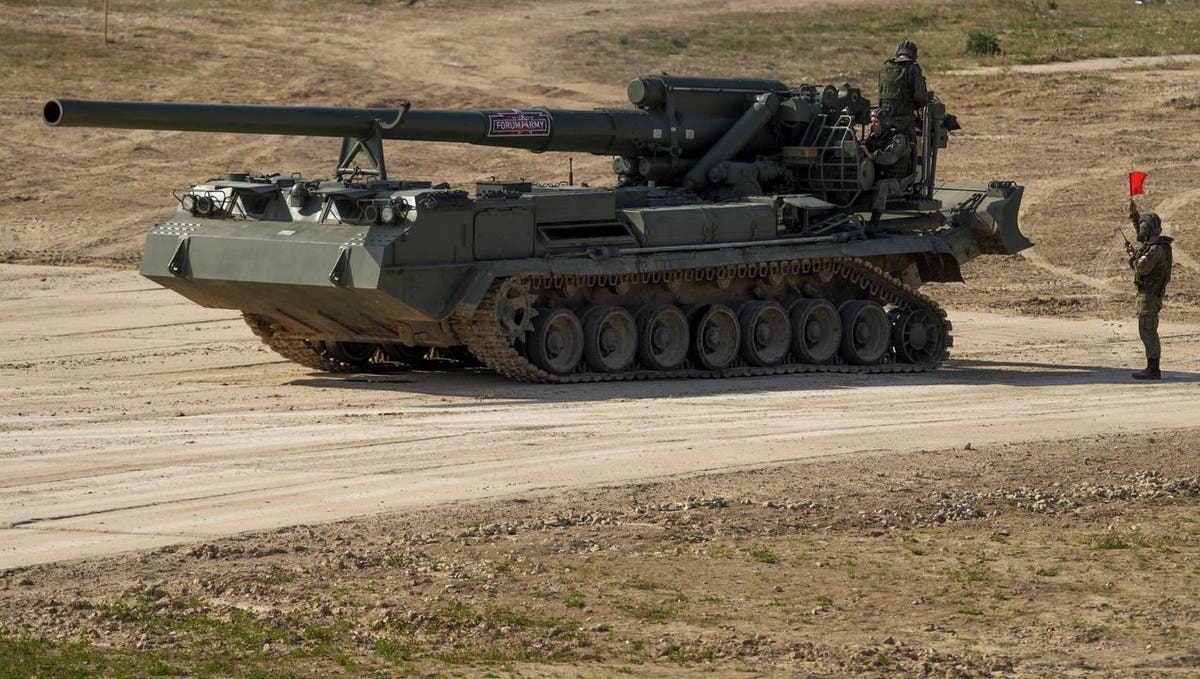Russia’s giant 240mm self-propelled mortars are appearing in increasing numbers on the battlefield in Ukraine – and getting destroyed just as fast. The presence of this lumbering beast of war may be a sign that Russian artillery is increasingly overstretched and they are resorting to obsolete weapons with a poor chance of survival.
The 2S4 Tyulpan (“Tulip”) is the largest mortar in use in the world today. It is mounted on a tracked, armored vehicle, much like most modern self-propelled artillery, but rather than a long-range cannon it carries a huge, short-range mortar. The Tyulpan was first produced in 1959 and the last one rolled off the production line back in 1988, making it around 45 years old now – still younger than many of the tanks now in the Russian front line.
The biggest cannon in the U.S. Army’s arsenal is the 155mm howitzer on the M109 Paladin which throws a shell weighing about 100 pounds to a range of up to 25 miles. The Russian 240mm mortar lobs a bomb weighing up to 500 pounds to a range of 11 miles. It looks fearsome, and its rounds are devastating where they hit.
The size of the shells means a bigger crew is needed. While the M109 has a crew of six – commander, gunner driver and six ammunition handlers – the Tyulpan has a crew of nine for firing, four carried on the vehicle itself and another five who ride in a support vehicle.
Modern artillery fire missions are often described as ‘shoot and scoot,’ in which vehicles fire a few shots and then rapidly change position to avoid counter-battery fire. This is vital for survival in high-intensity conflict like the current one in which both sides deploy artillery-spotting radar and drones are constantly looking for guns firing behind enemy lines. The Tyulpan is poorly suited to this type of warfare as it takes around 25 minutes to prepare for firing, and fires just one round per minute. The Paladin can fire its first round within sixty seconds of halting, and can fire a burst of eight rounds in one minute before moving on.
The heavy mortar’s short range also means it has to be placed well forward and into the zone where it is more likely to be spotted and can be targeted by enemy weapons further away.
The Tyulpan resembles medieval siege gun, brought up to gradually batter down fixed defenses over a prolonged period. It is a specialized weapon not adapted to modern mobile warfare , and so was not much seen in the early stages of the war.
Ukraine destroyed the first Russian Tyulpan in May 22, and Russia lost a total of nine in the year up to this June. In June however, a spat of videos appeared of Tyulpans being hit. Oryx, meticulous recorder of Russian losses, notes four in June. which suggests that the rate of loss has increased by 600% in one month. A recent video from the end of the month may show a fifth Tyulpan being destroyed which would indicate an even steeper rise, and some may have been destroyed which have not yet identified.
There are more where those came from. Some 60 Tyulpans are in service, plus there are hundreds more in storage which could in theory be reactivated.
The bigger question is whether fielding more of these highly vulnerable systems would even be worthwhile, especially as nine crew members can be lost every time one is hit. The argument that anything is better than nothing may not hold true here.
There are other signs too in the casualties they take that Russian artillery is being degraded. On Twitter, Richard Vereker has analyzed open-source intelligence on Russian losses compiled by Warpsotting and looked at the changes month by month. Losses of 152mm artillery pieces, which are the mainstay or Russia’s artillery and which have previously suffered the highest losses, have dropped below the smaller 122mm caliber weapons for the last two months. This may be an indication that, after losing more than 300 152mm self-propelled guns and 170 towed 152mm guns, Russia is starting to run low. (Or, perhaps even worse for them, they may be running out of 152mm ammunition).
The early phases of the war were marked by Russia’s massive superiority in artillery, sometimes described as a seven-to-one advantage in artillery pieces. That advantage is disappearing fast if it has not already gone, and Ukrainian forces are now using artillery like the German-made 155mm PzH 2000 and truck-mounted 155mm Caesars as well as U.S.-supplied HIMARS multiple launch rocket systems.
It is hard to get reliable information on the state of the war. But based on the available information on casualties, Russia’s heavy mortar losses may be the first signs of serious problems with its artillery.
Read the full article here




